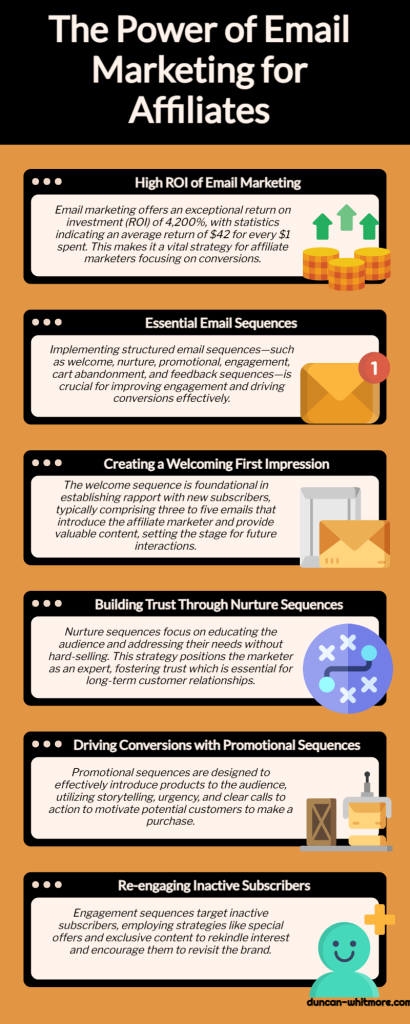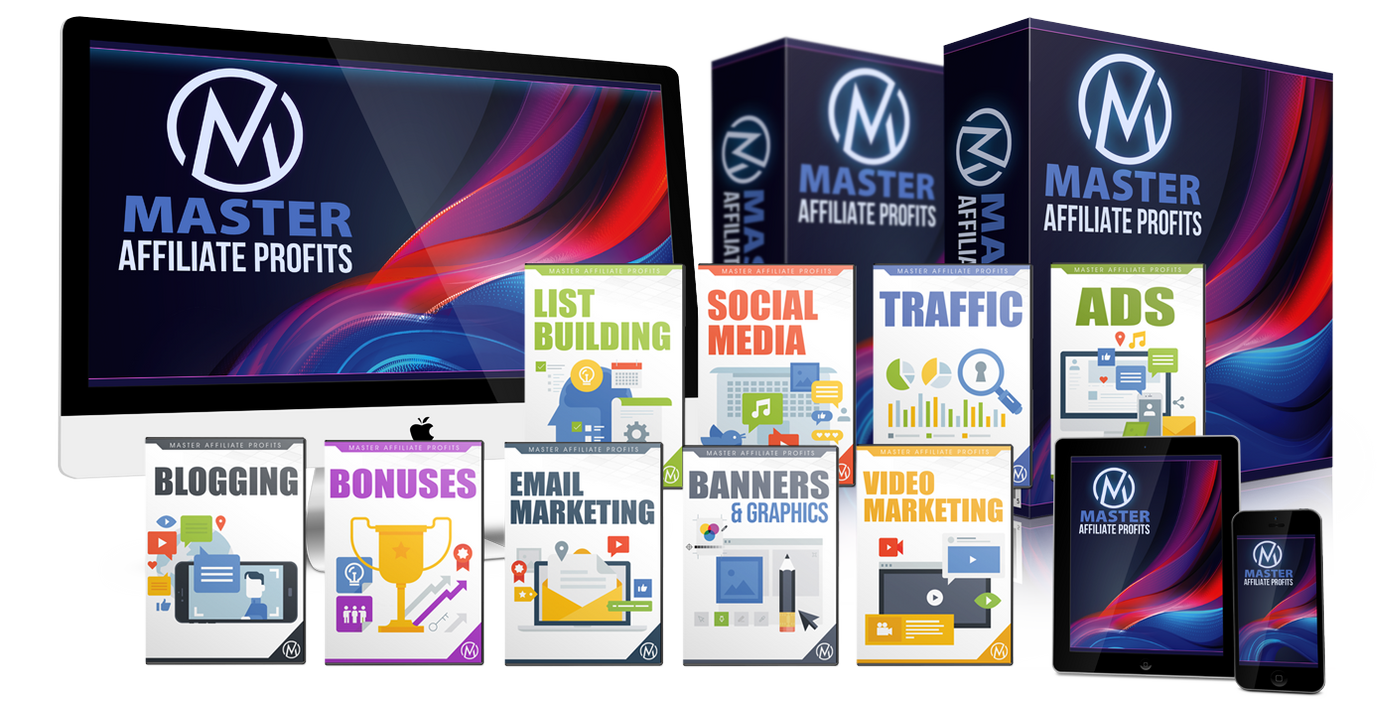4,200% ROI: The Power of Email Marketing for Affiliate Marketers
By Duncan Whitmore
We're back to one of my favorite topics today...
Email marketing remains a cornerstone strategy for affiliate marketers aiming to drive conversions and build loyal audiences. Despite the rise of social media and other digital marketing channels, email remains a reliable and powerful tool.
Indeed, according to statistics, email marketing delivers a return on investment (ROI) as high as $42 for every $1 spent[1] - that's 4,200%.
So as you can see, email marketing is an indispensable part of any affiliate marketing strategy.
At the heart of this effectiveness are email sequences or "campaigns". These are planned series of emails sent to subscribers at predetermined intervals to nurture leads and guide prospective customers down the conversion funnel.
But what are the best email sequences to boost an affiliate marketer’s conversions?
Here’s an in-depth look at the top sequences that every affiliate marketer should consider implementing.
Welcome Sequence
The journey for any subscriber starts with the welcome sequence. This initial series of emails is pivotal in setting the tone for your relationship with the subscriber. The aim here is to make a strong first impression and lay the groundwork for future interactions.
A typical welcome sequence consists of three to five emails.
The first email is sent immediately after sign-up, thanking the subscriber and briefly introducing the affiliate marketer. This ensures that the subscriber knows they’re in the right place.
Subsequent emails provide more value. It’s the perfect time to share your story, introduce the brand you’re promoting, and offer valuable content related to the product.
Whether you should monetize these earlier emails is a matter of debate.
Personally, I prefer to orient my subscribers into a buyer frame of mind from the start. Other email marketers prefer to build credibility first, making their audience more receptive to future promotions.
Nurture Sequence
Once your welcome sequence sets the foundation, a nurture sequence serves to build trust over time. This series of emails is educational and provides insightful content that addresses the problems and needs of your audience.
Unlike the hard sell, it's about developing a relationship and positioning yourself as an expert.
A successful nurture sequence is strategically tailored. It can include tips, how-to guides, case studies, and testimonials that relate to the products you’re promoting.
The key here is subtle persuasion, to educate and engage subscribers while keeping your affiliate products top of mind.
For example, if you are promoting health supplements, your nurture emails could share tips on maintaining a healthy lifestyle, backed by scientific studies.
Once again, whether you directly monetize this sequence is up to you. Either way, as soon as you present a particular product as part of the solution, you must ensure your audience is ready to consider it seriously.
Promotional Sequence
In affiliate marketing, promotional sequences are the driving force behind conversions. These sequences are designed to introduce your audience to a product you’re promoting and to encourage them to make a purchase.
A well-crafted promotional sequence should be integrated with storytelling, urgency, and clear call-to-action statements. The content should highlight how the product solves a problem and what exclusive benefits it offers.
Some email marketing education suggests that you should avoid "pushing" products all the time, as it may lead to unsubscribe actions or your emails being flagged as spam. Instead - so this thinking goes - you should intersperse promotions with value-laden content to increase conversion rates.
The problem with this approach is that it rests on a false dilemma between promoting products on the one hand and providing value on the other.
Provided that you are skillful, recommending useful products that meet the needs of your audience is providing them with value. So too is educating people on a problem that leads to a promotion as the solution.
Engagement Sequence
An engagement sequence is targeted at re-engaging subscribers who have become inactive. These sequences can include special offers or exclusive content designed to reignite a subscriber’s interest.
The first step is identifying inactive subscribers, which can be those who haven’t opened one of your emails in 30, 60, or 90 days (I go for 90).
A successful re-engagement email can remind them of the value they can derive from your emails. Offering a limited-time discount or exclusive access to premium content can be highly effective.
When traffic costs are so high, a focus on renewal rather than acquisition can yield better long-term results, especially for affiliate marketers trying to maintain a consistent client base.

Cart Abandonment Sequence
Cart abandonment sequences are a proven way to win back lost sales. Statistics show that almost 70% of online shoppers abandon their carts before completing a purchase [2].
For affiliate marketers, implementing an effective cart abandonment sequence can significantly boost conversions.
The first email in this sequence should be sent within a few hours of the cart's abandonment. This email serves as a gentle reminder of the incomplete transaction.
Subsequent emails can offer incentives such as discounts or free shipping (if possible) to persuade the customer to complete their purchase.
Additionally, introducing a sense of urgency, perhaps with a limited-time offer, can encourage faster decisions.
Feedback and Follow-up Sequence
Once a sale is completed, the role of a feedback and follow-up sequence comes into play. This sequence helps in establishing a long-term relationship with your customer, fostering loyalty, and generating repeat business.
The first email should thank the customer for their purchase and reiterate the benefits they’re set to enjoy.
Further emails can encourage customers to share their feedback, perhaps using a short survey or direct reply. Gathering feedback is invaluable as it informs future campaigns and can be used to improve product offerings.
Moreover, these follow-up emails can introduce new products, upsells, or complementary items, transforming a one-time buyer into a repeat customer.
By showing genuine concern for the customer’s satisfaction, you establish trust — a crucial commodity in affiliate marketing.
Conclusion
Email sequences are the backbone of a successful affiliate marketing strategy. By harnessing the power of each sequence — welcome, nurture, engagement, promotional, cart abandonment, and feedback — you can significantly enhance your conversion rates.
Consistency, relevancy, and value are the pillars that uphold these email strategies. As an affiliate marketer, embracing these sequences equips you with the tools needed to foster deeper relationships with your audience and drive sustained growth.
Remember to continuously analyze the performance of your email sequences, adjusting and fine-tuning them to meet the needs of your audience. In doing so, you not only boost conversions but also build a loyal community around your brand.
* * * * *





3 replies to "4,200% ROI: The Power of Email Marketing for Affiliate Marketers"
[…] After capturing leads, the goal is to nurture these prospects. You’ve got their attention; now, keep it. Through nurturing, you build a relationship and continue providing value. This is best done through email marketing. […]
[…] underestimate the power of a robust email marketing campaign. It's one of the most effective ways to maintain communication with your […]
[…] Email marketing remains one of the most effective tools for maintaining client relationships, provided it is done thoughtfully. Regularly cultivate your email list with subscribers who genuinely want to hear from you, and nurture these leads by sending out engaging newsletters, product updates, and exclusive offers. […]